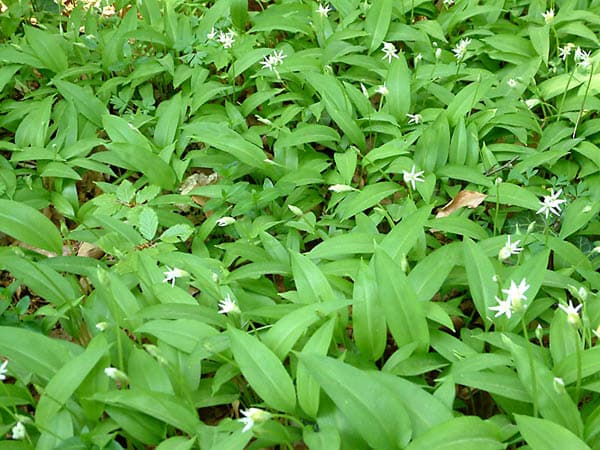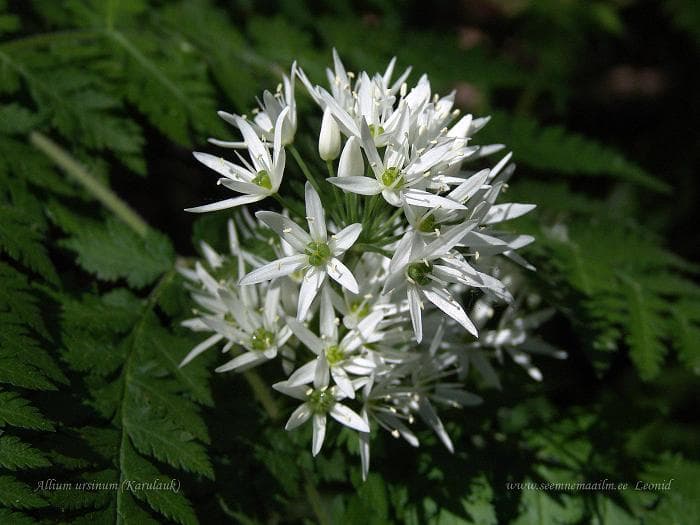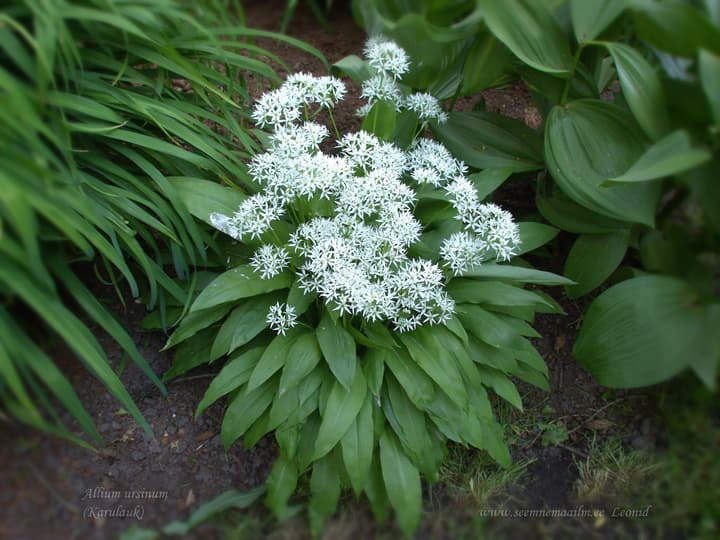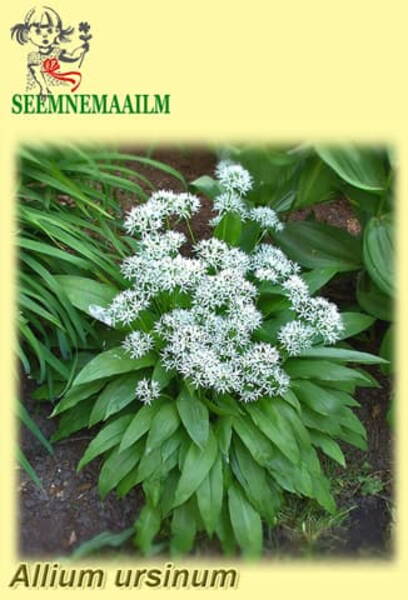Sensoric quality.
Perennial. Young shoots and leaves are used for food in fresh, salted, pickled, and dried forms.
Wild garlic greens have a pleasant slightly garlicky taste. The seeds are spherical and black. Weight of 1000 seeds = 6-7 g.
Seeds germinate only during winter sowing or after stratification.
The leaves grow back immediately after the snow melts within 25-30 days.
The collection of greenery is carried out at the end of May, cutting off the entire aerial part of the plant, preserving the bulb.
Cutting is carried out no more than once every 2-3 years in one place.

Sensoric quality.
Similar to garlic, but less strong and with a hint of chives. Main constituents Similar to garlic, bears garlic contains a large number of sulphur compounds: divinyl sulfide, dimethyl thiosulfonate, methyl cystein sulfoxide and the latters degradation products, methyl allyl thiosulfonate and methanethiol. Origin Native to Western and Central Europe. In the USA, ramp (Allium tricoccum), a wild plant with more onion-like flavour, is used for similar purposes. Etymology English ramson (Old English hramsan) is of unclear origin; cognates are found in several Germanic (e.g., Swedish ramslök and regional German Ramsen) and Slavic languages (e.g., Russian cheremsha [черемша]). There are, however, a few possibly related words in other Indo-European tongues: Greek krommyon [κρόμμυον] “onion” and maybe Welsh craf “garlic”. With the apparent exception of Northern Germanic, many names of bears garlic in European tongues translate to “bears garlic”, “bears leek” or “bears onion”.
Biological features.
Bear's garlic grows well in shading. Prefers moist loamy or sandy soils.
Grows in early spring (early April). Blooms in May-June. Seeds ripen in July.
Reproduction and agricultural technology.
Propagated by seeds and vegetatively - by daughter bulbs, which are laid two or three in the axils of the leaves.
Seeds are sown before winter, seedlings appear in April. It reproduces well by self-seeding. Agricultural technology of ramson is similar to onions.
Harvest.
Onions for greens are harvested before flowering, seeds - when the boxes darken. Otherwise, the boxes crack and the seeds spill out.
Medicinal properties.
The leaves contain vitamin C (150 mg%), essential oil and phytoncides.
In folk medicine, bear onion is used as an antiscorbutic, antihelminthic, anti-febrile and anti-cold remedy.
It increases appetite, stimulates the activity of the gastrointestinal tract. Raw onions are used for atherosclerosis, and their juice is instilled into the ear for purulent inflammation.
Alcohol tincture helps in the treatment of cough and rheumatism.
Application.
In appearance and taste, it resembles a victorious onion, but its smell is more tender. Ramson is a good preservative.
Crushed or finely chopped onions and leaves protect the meat from quick spoilage. In the Caucasus, both bulbs and stems with leaves are used in cooking.
Bulbs are dug up in autumn and used instead of garlic, and seedlings - at the end of winter and consumed fresh or boiled: seasoned with sunflower oil and vinegar, canned or salted.
Bear onions of the autumn collection are dried for the winter. At the same time, it partially loses its aroma but retains its taste. Dried spices are ground and seasoned with dishes.
Crushed onions are mixed with red pepper and sour cream and a very tasty seasoning for fish and meat is prepared.
The game stewed with bear onions becomes more tender and tasty.
They are seasoned with fillings. Familiar with wild garlic and some European cuisines. In Portugal, for example, eggplant is baked with this aromatic herb.

Wild wood garlic - a perennial rhizome plant with small false bulbs, rarely found in garden plots. It has long been used as a food, medicinal and ornamental plant. Young shoots and leaves are eaten fresh (for salads), and also as a seasoning in pickled, fermented and dried form. It has a strong bactericidal and tonic effect.
Ramson is effective for the treatment of gum diseases, atherosclerosis, hypertension, metabolic disorders.
Bulbs, flower stalks and young leaves of wild garlic (ramson) are used for medicinal purposes.
Ramson contains 10-15 times more vitamin C than lemons or oranges.
Wild garlic has an antimicrobial, antihelminthic effect, improves appetite and digestion, and enhances the secretory function of the gastrointestinal tract. It is used for flatulence, gastroenteritis, amenorrhea, neurasthenia, heart disease and dropsy.
The infusion of the bulb and grass is rubbed for coughs, rheumatism and bronchitis.
The leaves are applied to the eyes for inflammation. It is recommended for food for weakened vision.
The bulbs are used externally for boils and carbuncles. It is used in food as an iodine-containing, dietary and vitamin raw material.
It is eaten fresh, salted and pickled.
In folk medicine, this onion is used for fever, rheumatism, cough, for the treatment of scurvy, atherosclerosis, thyroid diseases and as an antihelminthic agent. It has a tonic, peptolytic and mild diuretic effect. Pies are stuffed with wild garlic, it is added to meat dishes, and served as an appetizer.
To remove the strong smell, wild garlic is doused with boiling water before pickling or fermenting.

The seeds must be stratified before sowing. To do this, soak the seeds in water for 3-4 hours, wrap them in a damp cloth and place them in a closed jar in the refrigerator for about 2 months at about +4°C. Plant the sprouted seeds in the soil. You can also sow before winter in the fall. Agricultural technology is the same as for chives.
Seedlings appear only in the 2nd year after sowing. In April, they produce 2 leaves, in June, growth stops. By autumn, leaf awls are formed. Only in the 3rd year do the plants branch out, and in the 4th year they bloom.
The vegetation period of wild garlic is short. Leaves grow back immediately after the snow melts for 24-29 days. The arrow appears in early June, and flowering begins in the middle of this month. Vegetation ends in early August. There is no secondary regrowth.
Ramson reproduces mainly vegetatively. Its disadvantage is that the reproduction rate is low. Only two bulbs grow from one annually.
It is collected at the end of spring, during the period of greatest vitamin deficiency, cutting off the entire above-ground part of the plant.

Ramson, ramsons, bear's garlic, broad-leaved garlic, buckrams, gypsy onion, hog garlic, wild garlic, wild wood garlic, wood garlic.
Pickled wild garlic.
Trim the wild garlic stems at both ends, wash, drain and soak for 2 hours in fresh cold water to remove bitterness. Bring 1 liter of water with salt, sugar and vinegar to a boil and cool to room temperature. Tie the stems into bunches of 10 or 20 pieces, place vertically in a tall jar and pour warm marinade. The stems should be completely covered with water. Marinate the wild garlic for 5-7 days in the refrigerator.
Wild garlic - 60 stems, salt - 1.5 tbsp., sugar - 1 tbsp., vinegar (9%) - 150 ml.
Preparation for green cabbage soup with wild garlic and sorrel.
Finely chop the greens, put them in an enamel bowl, add water and salt, put on the fire, boil for 5 minutes and immediately pour into pre-sterilized jars and roll up with sterile lids.
Sorrel - 800 g, wild garlic - 200 g, carrots (green leaves!) - 20 g, water - 200 ml, salt - 5 g.
Fresh wild garlic with oil.
Boil the prepared wild garlic for 5 minutes, let the water drain, cut into 2-3 cm pieces. Season with vegetable oil and salt. Serve as a separate dish or as a side dish for fish and meat dishes.
Fresh wild garlic - 200 g, sunflower oil - 15 ml, salt - to taste.
Paste of cottage cheese and sour cream with fresh wild garlic leaves.
Finely chop the washed wild garlic leaves and green onion feathers, mix with cottage cheese and sour cream, add salt and pepper. It is delicious to bake pancakes with this paste as a filling.
Green onions - 100 g, fresh wild garlic leaves - 150 g, cottage cheese - 300 g, sour cream - 200 g, ground black pepper and salt - to taste.
Salad with wild garlic, beets and feta cheese.
Cut the beets into thin slices. Chop the wild garlic and lettuce leaves. Add pieces of feta and pour in a dressing of vegetable oil, balsamic vinegar, pepper, salt and sugar. It will be delicious to add walnuts or sprinkle with black sesame seeds. The beets will taste better if you bake them instead of boiling them. Beetroot (baked or boiled) - 300 g, wild garlic (fresh) - 100 g, lettuce leaves - 100 g, feta cheese - 50 g.
For dressing: olive oil - 10 ml, balsamic vinegar - 15 ml, salt, ground black pepper and sugar - to taste.
Salad of fresh wild garlic leaves with sour cream.
Chop the washed wild garlic leaves, add chopped hard-boiled eggs, sour cream, pepper, salt, mix, put on a plate, garnish with cheese slices and herbs.
Fresh wild garlic leaves - 150 g, eggs - 4 pcs., cheese - 150 g, sour cream - 150 g, parsley (greens), ground black pepper and salt - to taste.
Spring salad of salted wild garlic.
Boil or bake potatoes, cut into cubes, mix with finely chopped wild garlic, salt and season with oil.
Potatoes - 4-5 pcs., cooked wild garlic - 1 bunch, sunflower oil and salt - to taste.
Cold soup with wild garlic.
Cut radishes and bell peppers into thin slices. Peel the cucumber and cut into thin circles. Cut the fennel and celery stalks into cubes. Finely chop the green onions, dill, cilantro and wild garlic. Cut the tomatoes into small pieces. Mix the vegetables and greens, salt and pepper. Boil the eggs, peel and cut each into 6 pieces. Mix the kefir and cooled vegetable broth. Put the vegetable mixture and one egg in each plate and pour in the kefir and broth mixture. Egg - 3 pcs., wild garlic (fresh) - 1 bunch, dill - 1 bunch, cilantro - 1 bunch, green onions - 1 bunch, fennel - 0.5 pcs., celery (stem) - 1 stalk, radish - 6 pcs., sweet pepper - 0.5 pcs., cucumber - 1 pc., cherry tomatoes - 6 pcs., salt and ground black pepper - to taste.
Filling: kefir - 300 ml, vegetable broth - 300 ml.
Potato soup with fresh wild garlic.
Pour diced potatoes into boiling broth or water and cook for 10-15 minutes. Add carrots and onions fried in butter. Add finely chopped wild garlic 7-10 minutes before the end of cooking.
Potatoes - 75 g, carrots - 10 g, onions - 10 g, butter - 10 g, fresh wild garlic - 75 g, meat broth (or water) - 320 ml, salt and spices - to taste.
Tomato soup with wild garlic.
Boil water, add coarsely chopped onions and tomatoes, herbs, salt, pepper and pour in a few tablespoons of oil. Cook over low heat until the onions are soft. Serve the finished soup with wheat croutons.
Water - 1.5 l, fresh wild garlic (chopped) - 2 bunches, onions - 2 pcs., tomatoes - 6 pcs., parsley (chopped) - 1 tbsp., vegetable oil - 2 tbsp., wheat croutons - 200 g, salt and ground black pepper - to taste.
Vegetable soup with mushrooms and wild garlic.
Put a saucepan with water (or meat or vegetable broth) on high heat.
Mushrooms that do not require pre-boiling, rinse with cold water, peel and cut into large slices.
Peel, wash and cut the potatoes. When the water boils, pour the potatoes into the pan. Peel, wash and grate the carrots on a coarse grater.
Dice the onion and fry until golden brown. Finely chop the wild garlic and add to the pan. Fry for another 2 minutes.
Add the mushrooms and fry for another 5 minutes. Add the carrots and cook for another 2 minutes. Then add sour cream and vegetables and simmer over medium heat for 5 minutes.
Add salt, spices and cook the soup until the potatoes are done, 20-25 minutes.
Mushrooms - 200 g, onions - 2 pcs., wild garlic - 0.5 bunch, carrots - 1 pc., potatoes - 7 pcs., sour cream - 1 cup, salt - 0.5 tbsp., vegetable oil - 3 tbsp., water (or broth) - 1.5 l.
Fish soup with fresh wild garlic.
Chop the onion. Finely chop the wild garlic, celery and carrot tops. Cut the fish into pieces and fry in vegetable oil together with the onions and finely chopped greens. Cut the potatoes into thin strips. Combine everything, pour boiling water over and cook until tender. Add chopped wild garlic, bring to a boil and add salt.
Serve with sour cream.
Fish - 500 g, potatoes - 200 g, onions - 50 g, fresh wild garlic - 200 g, celery (greens) - 50 g, carrot tops - 30 g, vegetable oil - 100 g, water - 3 l, salt - to taste.
Potato pancakes with wild garlic.
Peel, wash and grate the potatoes on a coarse grater. Wash and chop the wild garlic. Mix the potatoes and greens, add the egg, salt, pepper and flour, mix until smooth. Heat 1 tbsp of vegetable oil in a frying pan. Spoon the potato mixture into flat cakes. Fry the pancakes with greens on a fairly high heat for about 1.5-2 minutes on each side, adding oil if necessary.
Potatoes - 0.5 kg, wild garlic - 1 bunch, egg - 1 pc., flour - 2 tbsp., salt - 0.5 tsp., ground black pepper - 0.25 tsp., vegetable oil - 2-3 tbsp.
Cabbage rolls in wild garlic leaves.
Peel the onion, chop finely. Wash, peel and chop the carrots very finely. Sauté the chopped onion and carrot in vegetable oil and mix with the prepared raw minced meat, add salt. Wash the wild garlic leaves thoroughly. Put 1 tsp. of minced meat with vegetables on each leaf, form small cabbage rolls in the form of envelopes or tubes. Place them in a saucepan or saucepan, add 2 tbsp. sour cream, pour in salted water (no higher than the top layer of the cabbage rolls) and simmer under a lid over low heat until done.
Wild garlic (leaves) - as much as you have.
Proportion for minced meat: onions - 100 g, carrots - 100 g, minced meat - 250 g, sour cream - 2 tbsp, vegetable oil - 2 tbsp, salt - to taste.
For 200 g of green onions: flour - 300 g, egg - 1 pc., melted butter - 2 tbsp, sour cream - 0.5 cups, salt - to taste.
Pork fried with wild garlic.
Cut the prepared pork into strips. Cut the prepared fresh wild garlic into strips of about 3 cm. Heat the frying pan over high heat, pour in the vegetable oil and heat. Put the meat strips in the frying pan, pepper and salt. As soon as the pork turns white, put the wild garlic in the pan and stir. Fry over high heat for about 1 minute. Serve hot. It is best to use a salad of fresh vegetables or stewed vegetables as a side dish.
Pork - 150 g, wild garlic (fresh) - 500 g, vegetable oil - 50 g, ground red pepper and salt - to taste.












